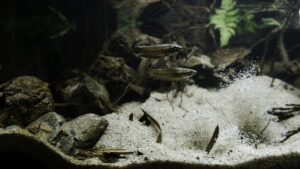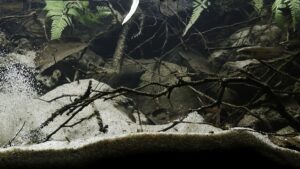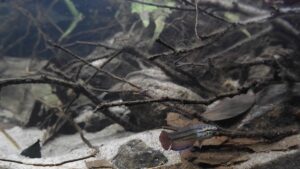Dancing Sands Spring, Situ Cisanti Bandung Indonesia

Volume of your aquarium: 64 Liter
Dimensions of your aquarium: 80x40x40 Cm (water is only 20 cm deep)
List of fishes: Betta Picta
List of plants: Blechum orientale L, Stenochlaena palustris, Davalia denticulata, Pteris Sp
Description of Decorations and Substrate: White-brown sands, Clay stones, river stone, senggani (Melastoma candidum) roots
Description of Equipment: 25 watt DIY Aquarium Fan
Amara Aerator AA 350
Kandila S Series 10.000 k 18 watt
Yukari sp 105, 2800L/H, 35 W
eksternal filter jebo canister 225
Water Parameters: 24-25 c, PH 6, TDS 70 ppm
Additional Info: Fall leaves are not essential, they are not allowed to accumulate, they are replaced every week. it’s like in nature the fallen leaves are drifting out of the spring pool. Replacement of water every week with reverse osmosis water 60%,
I made an L-shaped undergravel filter box with an opening in the water surface for blowing sand with a Yukari sp 105, 2800L/H, 35 W. Inside the box is filled with sponges and a biological system. Aerator increases oxygen and when blown by a fan is very effective in lowering water temperature
Aquarium video:
Description of the Area Surrounding the Biotope: Situ Cisanti is located at the foot of Mount Wayang which is an active volcano in the Bandung area at arboretum point 73. Mount Wayang (2181 masl) is a twin volcano with Mount Windu included in the category B volcano or a volcano that is in the fumarole/solfatara activity level. which since 1600 has never again held a magma eruption. The forest around the mountains is a protected forest
Description of the Underwater Landscape of the Biotope: The original form of the natural biotope is a
swamp with clear springs, but now it is managed as a tourist park.
Description of the Habitat Parameters: 20-26 c depending on the season, PH 6-7, TDS 50-90 ppm
List of Fishes and Invertebrates Occurring in the Nature Biotope: Betta picta, Trichopodus trichopterus, Puntius
Binotatus, and Osteochilus vittatus are native fish that are currently rarely
seen in the biotope. Currently this pond contains invasive fish such as
Cyprinus rubrofuscus, Oreochromis niloticus, Xiphophorus hellerii, african
chiclid
List of Plants Found in the Nature Biotope: Blechum orientale L
Stenochlaena palustris
Davalia denticulata
Pteris Sp
Melastoma candidum
Threats to the Ecology of the Biotope: When i was a kid, i found a lot of dancing sands spring in every river where i played. However, currently the dancing sand anomaly is very rare. Loss of water catchment areas, deforestation, overexploitation of groundwater are the contributing factors. I think that the biotope aquarium does not only discuss animals and plants, but also “Living Earth” this is one way to voice the warning of this water crisis, when the sand stops dancing, could humans be in danger?
My journey in search of “dancing sands springs” took me to the mountainous area of Bandung where the Citarum river is upstream, namely Situ Cisanti (1500 MASL). When I found the dancing sand spring in Cisanti, I found another problem, the invasive fish species. However, I was lucky to find a very exotic species of Java endemic fish hiding among the roots on the outskirts of the springs.
Sources of Information:
https://www.fishbase.se/summary/Betta-picta.html
Betta picta – Spotted Betta (Panchax pictum, Betta trifasciata)
https://www.researchgate.net/publication/270508667_Redescription_of_Betta_picta_Teleostei_Osphronemidae_and_description_of_B_falx_sp_n_from_central_Sumatra
https://ejournal.upi.edu/index.php/gea/article/download/4182/3011
http://geografi.ppj.unp.ac.id/index.php/student/article/view/1391/514





